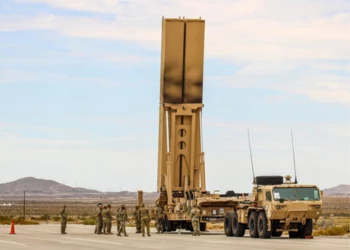Strengthening UAS Security with Lessons from the Paris Olympics
Add bookmarkListen to this content
Audio conversion provided by OpenAI

The anticipation is building as the U.S. prepares to host two of the world's most significant sporting events: the FIFA World Cup in 2026 and the Summer Olympics in 2028. With these events come opportunities and challenges, especially in the realm of security. In particular, drones, or Unmanned Aerial Systems (UAS), have become increasingly accessible and affordable. As a result, there is a growing potential threat of malicious actors using drones to attack or disrupt large-scale events.
Law enforcement and military at the 2024 Paris Olympics showcased a comprehensive counter-UAS (C-UAS) strategy aimed at mitigating risks associated with unauthorized drones. Now with the next series of global sporting events set to take place on American soil, U.S. law enforcement and security agencies must adapt lessons learned from Paris into their strategy for upcoming sporting events. This article will provide an overview of French efforts to mitigate drone threats at last summer’s Olympics and highlight which of those efforts can be replicated by U.S. law enforcement.
IDGA’s C-UAS Summit taking place this August 19-20 in Washington, DC provides the American security industry with an opportunity to discuss the emerging UAS threat. Across two days of learning and collaboration, we will engage our audience with high level discussions surrounding kinetic and non-kinetic approaches for countering drones, including exploring case studies on specific incidents, insights into the latest innovative C-UAS technologies, the impact of shifting legal authorities, and much more.
CUAS at the Paris Olympics
Leaders in France implemented a multi-layered defense strategy to detect, track, and neutralize unauthorized drones. The approach integrated technologies such as:
- PARADE System: A modular C-UAS system with radar, RF detection, electro-optical tracking, and jamming capabilities.
- Giraffe 1X Air Surveillance Radar: Used to monitor airspace in Paris and Marseille, providing real-time tracking of aerial threats.
- Handheld Jammers (NEROD RF Rifles): Portable countermeasures deployed to law enforcement for rapid drone neutralization.
- AI-Enabled Sensor Fusion: Combined data from various sensors for a comprehensive and real-time air picture.
Implementing the right technologies are just one part of French law enforcement’s strategy. Another key element was organizing political action. Leading up to the games French lawmakers reinforced its C-UAS capabilities with strong legal frameworks, allowing security forces to act decisively against aerial threats. Key policies enacted by the French government included:
- Pre-Designated No-Fly Zones: Strictly enforced airspace restrictions over key venues.
- Strict Regulations on Drone Use During the Olympics: Clear penalties for unauthorized flights deterred drone incursions.
- Pre-Approved Counter-UAS Authorization: Enabled rapid response by security agencies without bureaucratic delays.
Additionally, the French government established an inter-departmental mission led by the French Air and Space Force (AAE). This initiative aimed to coordinate all available counter-UAS resources from various branches of the French security apparatus, including the Army, Gendarmerie, and Police, to establish comprehensive air security at very low altitudes.
Results of French C-UAS Efforts
According to a report by the French National Assembly, a total of 355 unauthorized drones were detected during the Paris 2024 Olympic Games. This figure represents the total number of drone incursions identified by the aforementioned detection systems deployed throughout the event.
Prior to the official commencement of the Games, Prime Minister Gabriel Attal reported that French security forces were intercepting an average of six drones per day in the vicinity of Olympic sites.
IDGA’s 2025 Homeland Security Week this March featured a panel discussion on global security collaboration at the 2024 Paris Olympics. The panel featured Raphaël Juge, Police and Homeland Security Attaché for the French Embassy in Washington DC.
During the discussion, Juge mentioned that the PARADE system had positive effects.
“We jammed,” Juge said. “We managed to arrest 50 individuals and seized over 30 drones. So it was a very important aspect of the security.”
In total, French authorities arrested 81 individuals and seized over 50 drones thanks to their arsenal of technology solutions.
Juge added that not all of the intercepted drones were flown with malicious intent. Many of the incursions were attributed to amateur drone operators who were either unaware of the strict no-fly zone regulations or were simply attempting to capture aerial views of the Olympic venues.
Lessons for U.S. Law Enforcement
The 2026 World Cup is set to host games across 16 cities in North America, 11 of which are in the U.S. Two years later, Los Angeles is set to host the Summer Olympics across the cities sprawling urban landscape. Both large-scale sporting events will have to navigate the challenges of the securing the air from UAS threats, however, they already have a unique case study to reference in the 2024 Paris Olympics.
For example, France also had to contend with the complexities of a dense urban environment, including electromagnetic interference and line-of-sight limitations. Cities like Los Angeles, and the multiple locations for the World Cup, present similar challenges. US agencies should prioritize technologies that can operate effectively in urban settings, minimizing collateral damage and interference with essential communications. This means testing and validating systems in similar urban environments before the events.
Beyond navigating C-UAS in urban environments, the U.S. can also apply France’s integrated planning strategy. French established an interdepartmental mission led by the Air and Space Force early in the planning process. This fostered coordination between military, police, and other security agencies. American law enforcement needs to begin integrated planning now, involving federal, state, and local agencies. This includes the FBI, DHS, FAA, state police, and local sheriff/police departments.
U.S. law enforcement should also apply France’s layered technology approach to ensure no aspect of UAS threats are left unchecked. U.S. agencies should invest in a diverse range of C-UAS technologies. This includes advanced radar systems, drone detection software, electronic warfare tools, and potentially directed energy weapons. They should also consider mobile and rapidly deployable systems, to allow for quick reaction to emergent threats.
Ultimately, the success of U.S. law enforcement’s C-UAS strategy at upcoming sporting events will not be dependent on any one solution, but rather the calculated implementation of each of these elements. U.S. security agencies must foster a collaborative environment across federal, state, and local levels, it must work with technologies and technology providers capable of integration, and finally, the government must take steps to inform and educate the American public on safe drone usage.






















